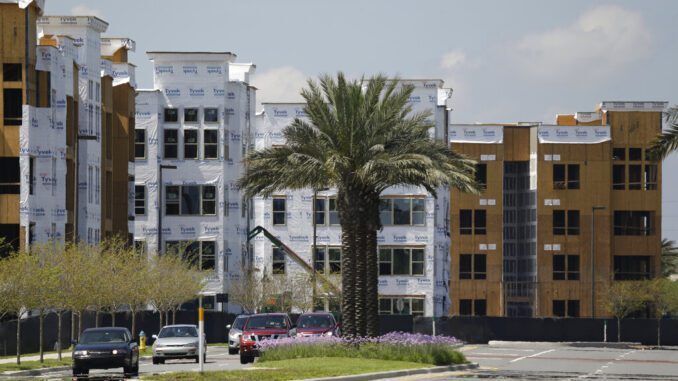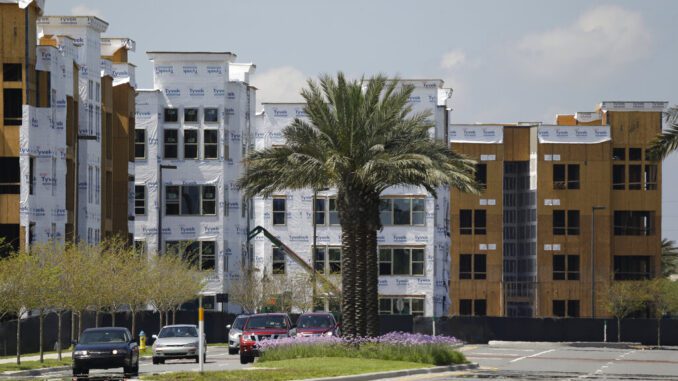

ORLANDO, Fla. — The U.S. population center is on track this decade to take a southern swerve for the first time in history, and it’s because of people like Owen Glick, who moved from California to Florida more than a year ago.
Last year, the South outgrew other U.S. regions by well over 1 million people through births outpacing deaths and domestic and international migration, according to population estimates from the U.S. Census Bureau. The Northeast and Midwest lost residents, and the West grew by an anemic 153,000 people, primarily because a large number of residents left for a different U.S. region. The West would have lost population if not for immigrants and births outpacing deaths.
In contrast, the South grew by 1.3 million new residents, and six of the 10 U.S. states with the biggest growth last year were in the South, led in order by Texas, Florida, North Carolina and Georgia.
Experts aren’t sure at this point if the dramatic pull of the South is a short-term change spurred by the COVID-19 pandemic or a long-term trend, or even what impact it will have on the reallocation of political power through redistricting after the 2030 census. Because of delays caused by the pandemic, changes were made in how the Census Bureau has calculated the estimates this decade, and that, too, may have had an impact.
But experts say the Southern allure has to do with a mix of housing affordability, lower taxes, the popularity of remote work during the pandemic era and baby boomers retiring.
Glick, 56, moved to the Orlando area from metro San Diego in December 2021 after he retired from his job in corporate sales. He had been making regular trips to central Florida before the move, to check on rental properties purchased because they were more affordable in the Sunshine State than in Southern California.
While the cost of housing and food is lower than in California, there are hidden home upkeep costs in Florida, such as the need to paint more often because of the unrelenting sun and higher utility bills from year-round air conditioning, he said.
“You’re in better financial shape in terms of prices here, but there are more expenditures to maintain properties,” Glick said.
Glick was among the 233,000 people who left a Western state and planted roots in a different region from mid-2021 to mid-2022. He joined the ranks of the almost 868,000 people who moved to a Southern state from another region.
If the trend continues through the rest of this decade, by 2030 the mean center of the U.S. population will head due south from a rural county in the Missouri Ozarks, without a westward extension for the first time in history, according to urban planner Alex Zakrewsky, who models the population center.
Since the population center was first calculated to be in Chestertown, Maryland, in 1790, it has moved continuously westward, though it started taking a more southwestern tilt in the 20th century as the spread of air conditioning made the South more livable.
North Carolina state demographer Michael Cline said the growth in the South has been “above and beyond” trends the region experienced before the pandemic, which he thinks may have accelerated many movers’ decisions to relocate from cold-climate states or allowed people to work remotely for the first time.
The departures from the West started in 2021, during the first full year of the pandemic, when 145,000 residents moved to another U.S. region. Up until then, domestic migration to the West had increased each year since 2010.
A substantial portion of the departures was due to people leaving California, but Alaska, Hawaii, New Mexico, Oregon and Washington also had year-to-year losses in domestic migration from 2021 to 2022. Additionally, in several Western states that had year-to-year increases in domestic migration — Arizona, Idaho, Montana, Nevada and Utah — those increases were smaller than in the previous year.
In Oregon, the jury is still out on whether the phenomenon of more than 17,000 departures to other U.S. states was a temporary, pandemic-related trend due to remote-working freedoms and housing affordability, or whether it’s a longer-term movement due to quality of life issues such as crime, weather or wildfires, said Josh Lehner, an economist for the state.
William Frey, a demographer at the Brookings Metro think tank, also wants to see if the trend is only related to the pandemic or has legs through the rest of the decade. A big wild card is immigration, which was responsible for most of the growth in 2022, he said.
“Some of that has to do with getting away from the big dense coastal metros to somewhere else,” Frey said. “One thing that needs to be questioned is if the patterns of the past two years will continue for the rest of the decade.”



